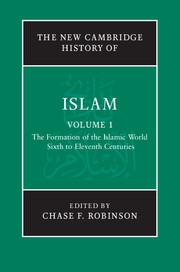Book contents
- Frontmatter
- Introduction
- PART I THE LATE ANTIQUE CONTEXT
- 1 The resources of Late Antiquity
- 2 The late Roman/early Byzantine Near East
- 3 The late Sasanian Near East
- 4 Pre-Islamic Arabia
- PART II UNIVERSALISM AND IMPERIALISM
- PART III REGIONALISM
- PART IV THE HISTORIOGRAPHY OF EARLY ISLAMIC HISTORY
- Conclusion: From formative Islam to classical Islam
- Glossary
- Bibliography
- Index
- Plate Section
- References
4 - Pre-Islamic Arabia
from PART I - THE LATE ANTIQUE CONTEXT
Published online by Cambridge University Press: 28 March 2011
- Frontmatter
- Introduction
- PART I THE LATE ANTIQUE CONTEXT
- 1 The resources of Late Antiquity
- 2 The late Roman/early Byzantine Near East
- 3 The late Sasanian Near East
- 4 Pre-Islamic Arabia
- PART II UNIVERSALISM AND IMPERIALISM
- PART III REGIONALISM
- PART IV THE HISTORIOGRAPHY OF EARLY ISLAMIC HISTORY
- Conclusion: From formative Islam to classical Islam
- Glossary
- Bibliography
- Index
- Plate Section
- References
Summary
Tribal historiography
The literary sources in Arabic dealing with pre-Islamic Arabia are copious, but rarely give direct answers to questions which are of interest to modern research. Still, the following had to be based on these sources since Arabian archaeology is only emerging; one hopes that significant Arabian pre-Islamic sites incur no damage before they are excavated.
Arabian society was tribal and included nomadic, semi-nomadic and settled populations. The settled populations had genealogies similar to those of the nomads and semi-nomads, identifying them as either ‘northern’ or ‘southern’ through the identity of their presumed eponyms. Not only did genealogy define the individual tribe, it also recorded its links with other tribes within families of tribes or tribal federations, each including several or many tribes. Muḥammad’s tribe, Quraysh, for example, was part of the Kināna, and hence the other tribes of the Kināna were its closest relatives. The settled populations, which probably included more people than the nomadic and the semi-nomadic populations put together, do not receive a proportionate share in the literary sources because the limelights are typically on the nomads, more precisely on their military activities, no matter how insignificant. Tribal informants focused on the military activities since the performance of town dwellers in the realms of trade and agriculture were less spectacular, and hence less contributive to tribal solidarity.
Keywords
- Type
- Chapter
- Information
- The New Cambridge History of Islam , pp. 153 - 170Publisher: Cambridge University PressPrint publication year: 2010
References
- 4
- Cited by

